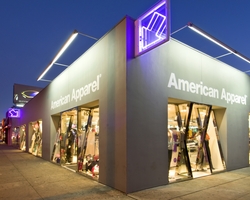I got a few direct messages asking if I was selling American Apparel ($APP) after its huge run up over the last few weeks. That is not the game I play. I like talking about my ideas with like minded investors but don't lean on me to make buying and selling decisions. You must do your homework. This is a distressed situation and it is not suitable for the majority of investors. Define the game you want to play and play it.
There is much more value in learning about processes than specific situations. In a nutshell here is the game I play.
I buy one distressed situation once about every 3 to 5 years. I can sit still for 5 years until I find something that suits my fancy. I am looking for distressed companies (brands) that are unique and have texture. Brands that are polarizing. Brands that people talk about for better or worse. I like them cheap and the further they fall from their apex the more excited I get. It is truly hard to keep a kick ass company on its ass for a long time. The long-run earning power of the company by my own estimate should justify a 10 to 20 times recovery from depressed levels.
Sometimes the idea fails and the stock falls to zero. For that reason, I want to get paid in aggregate for taking distressed securities' risk.
When I am invested in a successful situation, I am patient. I can and will wait years if I have to. $APP is up a few percent, but that is peanuts compared to what I am looking to earn. If anything, now is time to buy more, since each new data point that we get from the company seems to confirm our original bullish thesis. This type of investment is about making the right decision based on the data, and it is not about making a few percent on momentum.
When I bought $CROX in 2008 and early 2009, it was trading at about $1. It was a risky situation, similar to $APP, but I had faith in the brand. The stock rose 10%, then 20%, then 100%, to $2. Did I sell? No. Now, nearly 4 years later it is trading at $17 and I am still long. That is a 1700% return, and I am not ready to sell.
Written by Michael Bigger. Follow me on Twitter and StockTwits.
P.S. Please do your research before you trade the stock. This is a highly risky situation and it is not suitable for the majority of investors. The purpose of the post is to write down how I think about this and share it with you. I am currently long APP.
Back in 2008, I contemplated investing in a liquor store. I discovered I would have needed to purchase a substantial amount of quantity in order to get the lowest prices on each kind of alcohol, resulting in a sizable initial investment to purchase the inventory. With such a large initial investment requirement (I estimated it at about half of a million dollars), one would think that margins on the business going forward would be relatively high. What I found was that the average gross margin (just revenues minus COGS) not even counting overhead)) was around 5-10%. I did not make the investment.
Thinking about it years later, it makes total sense. A grocery store’s food can spoil. A restaurant has so many moving parts (wait staff, chefs, tons of ingredients to purchase). etc. The risks to those businesses are so much higher. How much can go wrong in a liquor business? Products don’t (typically) spoil. There aren’t so many SKUs. It’s an extremely “clean” business model, easy to mange = not as many risks. The profits “needed” to make it worthwhile – to compensate for the risks taken – do not need to be so high.
I learnt a valuable lesson from this, which I apply to my investments all the time. For every risk an investment has, the investment should have the ability to earn you a higher return when compared to an equivalent investment ex that risk.
You need to be compensated for the risks that you are taking.
So while I focused on the “after the fact” in last week’s post titled Hindsight is always 20/20, the same holds true when initiating an investment.
Look at APP… @biggercapital has been talking about it a lot recently on his blog. Their CEO is a risk. The company’s balance sheet is a tremendous risk. Even with their recent capital infusion, their ability to finance future operations will be a challenge. For these risk, (and many more that I’m sure they have) you should be awarded a higher return.
Is it a wise investment at this stage? I don’t know. One thing I am sure of however, is that if you are buying it to make a 10% or 20% return, you are making a huge mistake. You should a have much higher hurdle rate – a required minimum return – to invest in a situation like that. (Michael Bigger has mentioned many times in the past that he’s looking for well over a 100% return on it (& he has had a good record with other apparel companies in similar situations. See CROX))
So whether you own or plan on buying APP or a similar company, make sure you’re properly playing the odds.
Make sure you GET PAID!
- MicroFundy

 Thursday, February 28, 2013 at 5:33PM
Thursday, February 28, 2013 at 5:33PM


